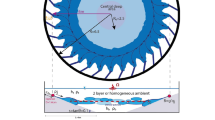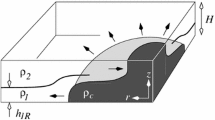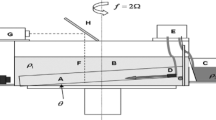Abstract
Results from numerical simulations of idealised, 2.5-dimensional Boussinesq, gravity currents on an inclined plane in a rotating frame are used to determine the qualitative and quantitative characteristics of such currents. The current is initially geostrophically adjusted. The Richardson number is varied between different experiments. The results demonstrate that the gravity current has a two-part structure consisting of: (1) the vein, the thick part that is governed by geostrophic dynamics with an Ekman layer at its bottom, and (2) a thin friction layer at the downslope side of the vein, the thin part of the gravity current. Water from the vein detrains into the friction layer via the bottom Ekman layer. A self consistent picture of the dynamics of a gravity current is obtained and some of the large-scale characteristics of a gravity current can be analytically calculated, for small Reynolds number flow, using linear Ekman layer theory. The evolution of the gravity current is shown to be governed by bottom friction. A minimal model for the vein dynamics, based on the heat equation, is derived and compares very well to the solutions of the 2.5-dimensional Boussinesq simulations. The heat equation is linear for a linear (Rayleigh) friction law and non-linear for a quadratic drag law. I demonstrate that the thickness of a gravity current cannot be modelled by a local parameterisation when bottom friction is relevant. The difference between the vein and the gravity current is of paramount importance as simplified (streamtube) models should model the dynamics of the vein rather than the dynamics of the total gravity current. In basin-wide numerical models of the ocean dynamics the friction layer has to be resolved to correctly represent gravity currents and, thus, the ocean dynamics.






Similar content being viewed by others
References
Baringer MO, Price JF (1997) Momentum and energy balance of the mediterranean outflow. J Phys Oceanogr 27:1678–1692
Emms PW (1998) Streamtube models of gravity currents in the ocean. Deep-Sea Res 44:1575–1610
Ezer T (2005) Entrainment, diapycnal mixing and transport in three-dimensional bottom gravity current simulations using the Mellor–Yamada turbulence scheme. Ocean Model 9:151–168
Ezer T, Weatherly GL (1990) A numerical study of the interaction between a deep cold jet and the bottom boundary layer of the ocean? J Phys Oceanogr 20:801–816
Ermanyuk EV, Gavrilov NV (2007) A note on the propagation speed of a weakly dissipative gravity current. J Fluid Mech 574:393–403
Frisch U, Kurien S, Pandit P, Pauls W, Ray SS, Wirth A, Zou J-Z (2008) Hyperviscosity, Galerkin truncation, and bottlenecks in turbulence. Phys Rev Lett 101:144501
Garrett C, MacCready P, Rhines P (1993) Boundary mixing and arrested Ekman layers: rotating stratified flow near a sloping boundary. Annu Rev Fluid Mech 25:291–323
Gill AE (1982) Atmosphere-ocean dynamics. Academic, London, pp 662
Griffiths RW (1986) Gravity currents in rotationg systems. Annu Rev Fluid Mech 18:59–89
Killworth PD (1977) Mixing on the Weddell Sea continental slope. Deep-Sea Res 24:427–448
Killworth PD (2001) On the rate of descent of overflows. J Geophys Res 106:22267–22275
Killworth PD, Edwards NR (1999) A turbulent bottom boundary layer code for use in numerical ocean models. J Phys Oceanogr 29:1221–1238
Lane-Serf GF, Baines PG (1998) Eddy formation by dense flows on slopes in a rotating fluid. J Fluid Mech 363:229–252
Lane-Serf GF, Baines PG (2000) Eddy formation by overflows in stratified water. J Phys Oceanogr 30:327-337
Legg S, Hallberg RW, Girton JB (2006) Comparison of entrainment in overflows simulated by z-coordinate, isopycnal and non-hydrostatic models. Ocean Model 11:69–97
MacCready P (1994) Frictional decay of abysal boundary currents. J Mar Res 52:197–217
Meacham SP, Stephens JC (2001) Instabilities of currents along a slope. J Prog Oceanogr 31:30–53
Nof D (1983) The translation of isolated cold eddies on a sloping bottom. Deep-Sea Res A 30:171–182
Pedlosky J (1998) Ocean circulation theory. ISBN: 978-3-540-60489-1. Springer, Berlin Heidelberg New York, p 453
Price JF, Baringer MO (1994) Outflows and deep water production by marginal seas. Prog Oceanogr 33:161–200
Price JF, Yang J (1998) Marginal sea overflows for climate simulations. In: Cassignet E, Verron J (eds) Ocean modeling and parameterization. Kluwer, Dordrecht, pp 155–170
Shapiro GI, Hill AE (1997) Dynamics of dense water cascades at the shelf edge. J Phys Oceanogr 27:2381–2394
Shapiro GI, Zatsepin AG (1997) Gravity current down a steeply inclined slope in a rotating fluid. Ann Geophys 15:366–374
Smith PC (1975) A stream tube model for bottom boundary currents in the ocean. Deep-Sea Res 22:853–873
Smith PC (1977) Experiments with viscous source flows in rotating systems. Dyn Atmos Ocean 1:241–272
Stull RB (1988) An introduction to boundary layer meteorology. Kluwer, Dordrecht
Sutherland BR, Nault J, Yewchuk K, Swaters GE (2004) Rotating dense currents on a slope. Part 1. Stability. J Fluid Mech 508:241–264
Umlauf L, Arneborg L, Burchard H, Fiekas V, Lass HU, Mohrholz V, Prandke H (2007) Transverse structure of turbulence in a rotating gravity current. Geophys Resea Lett 34:L08601. doi:10.1029/2007GL029521
Weatherly GL, Kelley Jr EA, (1982) Too cold bottom layers at the base of the Scotian Rise. J Mar Res 40:985–1012
Wirth A (2005) A non-hydrostatic flat-bottom ocean model entirely based on Fourier expansion. Ocean Model 9:71–87
Wirth A, Verron J (2008) Estimation of friction parameters and laws in 1.5D shallow-water gravity currents on the f-plane, by data assimilation. Ocean Dyn doi:10.1007/s10236-008-0151-8
Wu W, Danabasoglu G, Large WG (2007) On the effects of parameterized Mediterranean overflow on North Atlantic ocean circulation and climate. Ocean Model 19:31–52
Acknowledgements
I am grateful to Bernard Barnier, Yves Morel, Joel Sommeria and Jacques Verron for discussion and to two anonymous reviewers for their remarks which have greatly improved the paper. This work is part of the COUGAR project funded by ANR-06-JCJC-0031-01.
Author information
Authors and Affiliations
Corresponding author
Additional information
Responsible Editor: Eric Deleersnijder.
Appendix: Force balance in a rotating gravity current
Appendix: Force balance in a rotating gravity current
In the x direction (upslope), the dominant force balance is between the Coriolis force and reduced gravity. In the y direction, the reduced gravity vanishes and the dominant force balance is between friction and the Coriolis force (Fig. 7). Using linear Ekman layer theory, I obtain:
As the angle of descent is small to leading order sinθ ≈ θ and \(\cos (\theta +\pi /4)\approx 1/\sqrt{2}\), Eq. 8 then gives:
Please note that this result depends only on the Ekman number and is independent of the velocity of the gravity current. The analysis presented here does not apply to the friction layer as the Ekman spiral is not complete and θ is not small in this case, but can be extended to cases with a turbulent Ekman layer using a quadratic drag law.
Force balance in a gravity current descending at an angle θ to the horizontal at a constant speed u. The Coriolis force is at an angle of 3 π/2 to the direction of propagation and the frictional force at an angle of 5 π/4. In a stationary state, these two forces balance the gravitational force: F Coriolis + F friction + F g = 0. Please note the turned coordinate system
Rights and permissions
About this article
Cite this article
Wirth, A. On the basic structure of oceanic gravity currents. Ocean Dynamics 59, 551–563 (2009). https://doi.org/10.1007/s10236-009-0202-9
Received:
Accepted:
Published:
Issue Date:
DOI: https://doi.org/10.1007/s10236-009-0202-9





